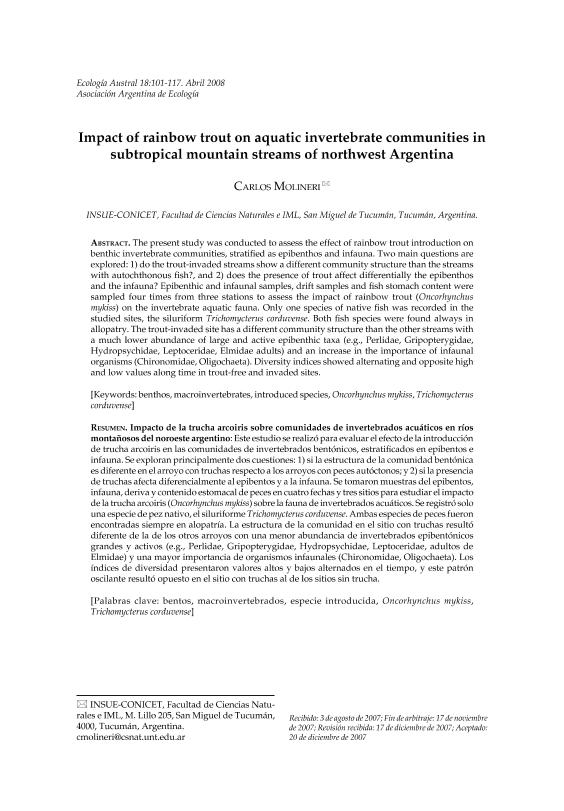Mostrar el registro sencillo del ítem
dc.contributor.author
Molineri, Carlos

dc.date.available
2019-08-15T19:44:59Z
dc.date.issued
2008-12
dc.identifier.citation
Molineri, Carlos; Impact of rainbow trout on aquatic invertebrate communities in subtropical mountain streams of northwest Argentina; Asociación Argentina de Ecología; Ecología Austral; 18; 1; 12-2008; 101-118
dc.identifier.issn
0327-5477
dc.identifier.uri
http://hdl.handle.net/11336/81676
dc.description.abstract
he present study was conducted to assess the effect of rainbow trout introduction on benthic invertebrate communities, stratified as epibenthos and infauna. Two main questions are explored: 1) do the trout-invaded streams show a different community structure than the streams with autochthonous fish?, and 2) does the presence of trout affect differentially the epibenthos and the infauna? Epibenthic and infaunal samples, drift samples and fish stomach content were sampled four times from three stations to assess the impact of rainbow trout (Oncorhynchus
mykiss) on the invertebrate aquatic fauna. Only one species of native fish was recorded in the studied sites, the siluriform Trichomycterus corduvense. Both fish species were found always in allopatry. The trout-invaded site has a different community structure than the other streams with a much lower abundance of large and active epibenthic taxa (e.g., Perlidae, Gripopterygidae, Hydropsychidae, Leptoceridae, Elmidae adults) and an increase in the importance of infaunal
organisms (Chironomidae, Oligochaeta). Diversity indices showed alternating and opposite high and low values along time in trout-free and invaded sites.
dc.description.abstract
Este estudio se realizó para evaluar el efecto de la introducción de trucha arcoiris en las comunidades de invertebrados bentónicos, estratificados en epibentos e
infauna. Se exploran principalmente dos cuestiones: 1) si la estructura de la comunidad bentónica es diferente en el arroyo con truchas respecto a los arroyos con peces autóctonos; y 2) si la presencia de truchas afecta diferencialmente al epibentos y a la infauna. Se tomaron muestras del epibentos, infauna, deriva y contenido estomacal de peces en cuatro fechas y tres sitios para estudiar el impacto de la trucha arcoiris (Oncorhynchus mykiss) sobre la fauna de invertebrados acuáticos. Se registró solo una especie de pez nativo, el siluriforme Trichomycterus corduvense. Ambas especies de peces fueron encontradas siempre en alopatría. La estructura de la comunidad en el sitio con truchas resultó
diferente de la de los otros arroyos con una menor abundancia de invertebrados epibentónicos grandes y activos (e.g., Perlidae, Gripopterygidae, Hydropsychidae, Leptoceridae, adultos de Elmidae) y una mayor importancia de organismos infaunales (Chironomidae, Oligochaeta). Los índices de diversidad presentaron valores altos y bajos alternados en el tiempo, y este patrón oscilante resultó opuesto en el sitio con truchas al de los sitios sin trucha.
dc.format
application/pdf
dc.language.iso
eng
dc.publisher
Asociación Argentina de Ecología

dc.rights
info:eu-repo/semantics/openAccess
dc.rights.uri
https://creativecommons.org/licenses/by-nc-sa/2.5/ar/
dc.subject
Benthos
dc.subject
Macroinvertebrates
dc.subject
Introduced Species
dc.subject
Oncorhynchus Mykiss
dc.subject
Trichomycterus Corduvense
dc.subject.classification
Ciencias de las Plantas, Botánica

dc.subject.classification
Ciencias Biológicas

dc.subject.classification
CIENCIAS NATURALES Y EXACTAS

dc.title
Impact of rainbow trout on aquatic invertebrate communities in subtropical mountain streams of northwest Argentina
dc.title
Impacto de la trucha arcoiris sobre comunidades de invertebrados acuáticos en ríos montañosos del noroeste argentino
dc.type
info:eu-repo/semantics/article
dc.type
info:ar-repo/semantics/artículo
dc.type
info:eu-repo/semantics/publishedVersion
dc.date.updated
2019-08-14T20:07:31Z
dc.journal.volume
18
dc.journal.number
1
dc.journal.pagination
101-118
dc.journal.pais
Argentina

dc.journal.ciudad
Buenos Aires
dc.description.fil
Fil: Molineri, Carlos. Consejo Nacional de Investigaciones Científicas y Técnicas. Centro Científico Tecnológico Conicet - Tucumán. Instituto de Biodiversidad Neotropical. Universidad Nacional de Tucumán. Facultad de Ciencias Naturales e Instituto Miguel Lillo. Instituto de Biodiversidad Neotropical. Instituto de Biodiversidad Neotropical; Argentina
dc.journal.title
Ecología Austral

dc.relation.alternativeid
info:eu-repo/semantics/altIdentifier/url/http://ojs.ecologiaaustral.com.ar/index.php/Ecologia_Austral/article/download/336/139
Archivos asociados
